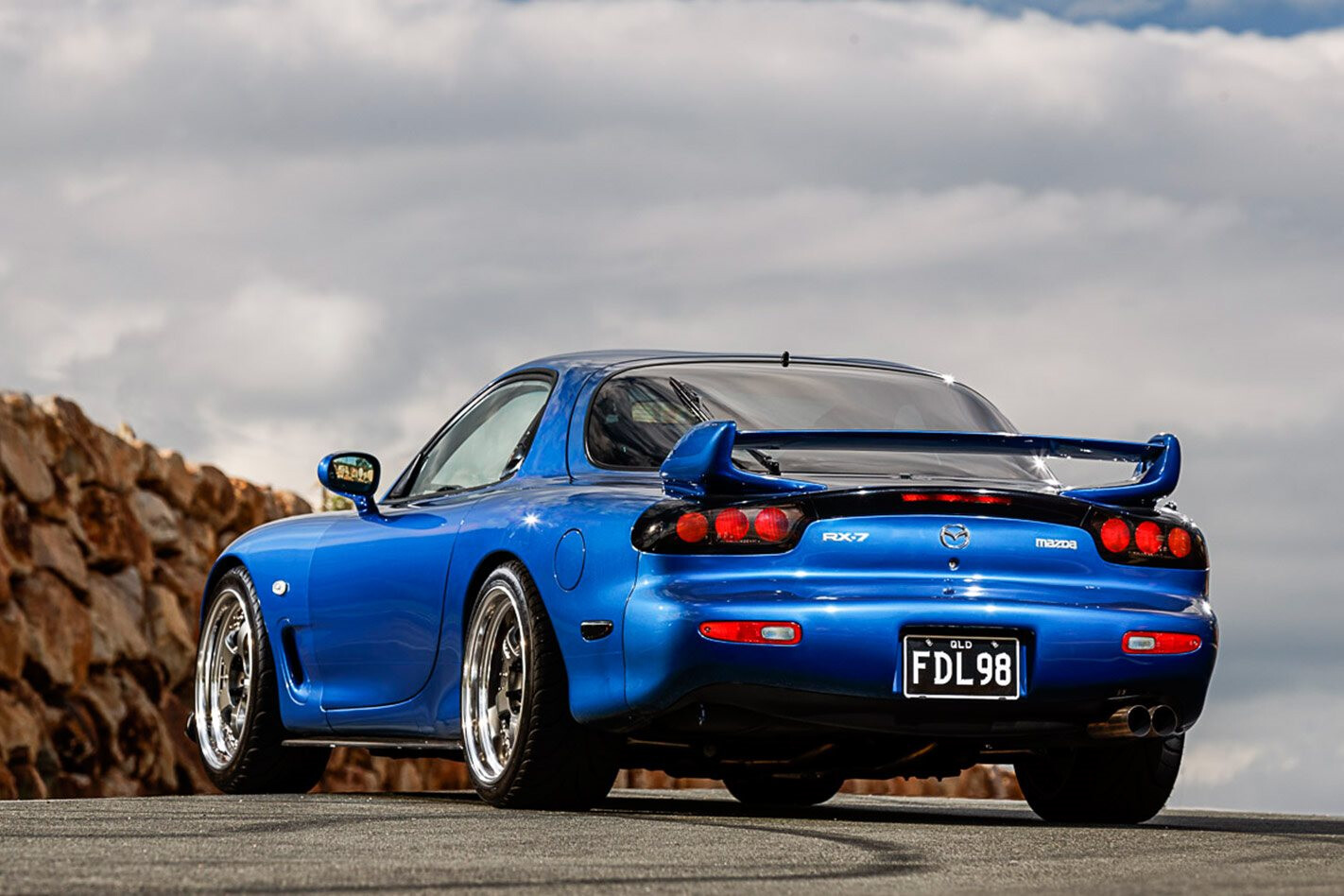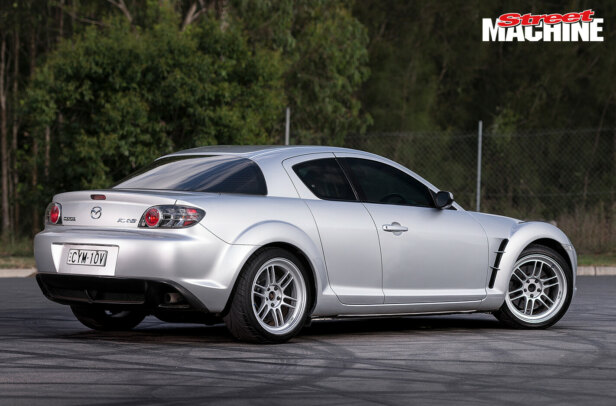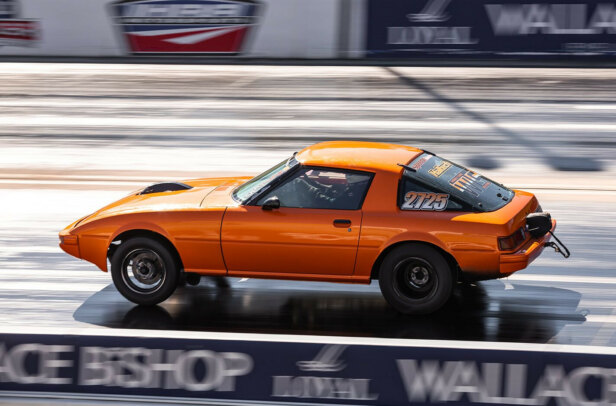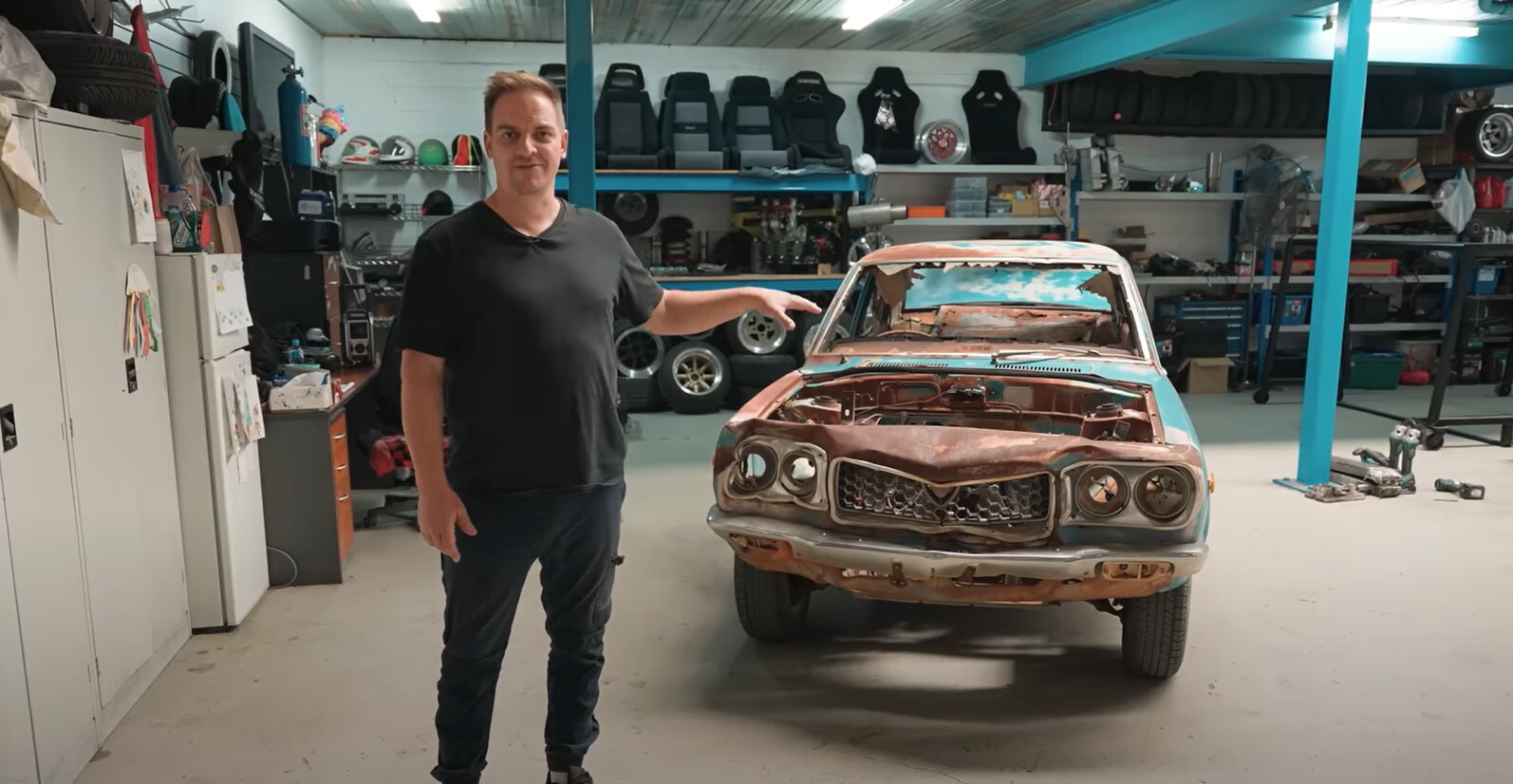This article on Luke’s RX-7 was originally published in issue no.7 of Street Machine’s LSX Tuner magazine, 2018
WHEN it comes to polarising opinions, few things beat the Wankel rotary engine. The pistonless motors used in Mazda’s performance cars since the late 60s might make a heap of grunt from their tiny mass, but they’re either loved or loathed, with seemingly no middle ground. Nobody seems to think rotaries are ‘okay’.
Behind the shapely front bar lies two PWR coolers (one for the power steering and the other for engine oil) flowing into a thermostat from Improved Racing. Luke has used Aussie components where possible, including plenty of Speedflow fittings on most fluid circuits
Luke Truskinger is one of the guys who is not on board with the triangle motors, despite the FD-generation Mazda RX-7 being one of the best-looking cars ever designed, in his opinion.
“My theory was, I’d procure one of my hero cars, an FD3S RX-7,” he explains. “And because I can’t speak rotary, I’d then remove the unwanted bits, which was anything containing oil. I’d then plug in an LS because it’s proven, simple, relatively unstressed and doesn’t completely destroy the chassis balance.
“Some brief research suggested there was not a huge weight increase in going V8 over the stock rotary, plus, fitting kits were available and have been done quite a bit in the USA, so there is lots of information out there. I like having something different, but I’m too time poor to pioneer something from scratch and make my own conversion bits.”
The Queensland engineer sourced a Series 8 example, the last of the RX-7 lineage, and arguably the most desirable, through an online forum. Purchased sight unseen from Canberra, he had the Type RS transported to Brisbane as a non-runner, where the project began.
One of the best shapes to ever come from Japan, Mazda’s third-generation RX-7 has already become a collectors’ item. Despite much love for rotary engines, the FD and Nissan S-chassis sports cars have both become common LS engine-swap recipients thanks to their excellent handling, build quality and underlying engineering
“After selling off the rotary drivetrain, I purchased a fitting kit from Justin Samberg in the USA to suit the LS and T56 into the FD,” Luke says. “I got the engine and trans mount kit, which is made up of front subframe, gearbox crossmember, bump-steer relocation kit, and drive-by-wire throttle pedal mount. I also picked up a Samberg radiator and a local header tank kit.”
Luke sourced a Gen IV L98 6.0-litre from a 2010 VE SS Thunder ute for the FD, though he didn’t leave it alone. With his choice of a 228/230/112 COMP cam, the pistons required fly-cutting to provide a relief for the valves due to the 0.570-inch lift of the bumpstick.
Though the bottom end is otherwise stock save for the cam and COMP lifters, compression has been bumped to 11.2:1 thanks to a 0.5mm skim of the rectangle-port heads, which also copped a five-angle valve job.
“I decided I wanted an L98 because I didn’t want to pay for an LS3, and 6.2 litres is borderline on the capacity limit under NCOP engineering laws, so I didn’t want to risk it,” Luke says. “The L98 has the L92 casting heads but no DOD, so it is pretty much ready to go.”
When kitting out the interior, Luke had to cut the driver’s floor out and make a custom recessed insert to allow his fixed-back Velo race seats to mount with enough clearance for him, given he stands 6ft 7in (2m) tall in his socks! The single-piece, bolt-in ’cage was carefully designed by Nathan Phipps at Mancave Projects around Luke’s height so it gives as much room as possible
Luke chose to run COMP pushrods and the COMP trunnion upgrade to the stock rockers, while the L98 oil pump was clearanced to fit the double-row COMP timing chain. Apart from a Walbro 455L-per-hour pump and a new fuel pressure regulator, the fuel system is stock, down to the 440cc injectors. The car is tuned to run on both 98RON PULP as well as E85 thanks to a Continental ethanol content sensor.
The L98 would have to be the pick of the many Gen IV engines available to fit into a light, handling-focussed performance car. Luke had to fly-cut his pistons due to his COMP 228/230/112 cam and skimmed heads, but has found the car performs beyond expectation, having made nearly 300rwkW and weighing just 1342kg with perfect 50:50 front-to-rear balance
Fitting the alloy LS into the low-profile FD nose required a GM F-body oil pan, which Luke upgraded with an Improved Racing trap door baffling kit and crank scraper, while HSV stainless headers worked well to fit around the stock Mazda steering shaft.
Fitting the 6.0L V8 to the low-slung engine bay with the Samberg kit required spacing the steering rack down and adding a bump-steer correction kit to ensure the car doesn’t buck or weave as it hits imperfections in the road surface
The transmission is a TUET8381 six-speed manual from the VE Thunder donor ute. You might not have heard of this model of Tremec but it is essentially a cross between the T56 and the later TR6060. Luke ran with a lightweight billet flywheel and full-face clutch set-up from Direct Clutch, passing the grumpy 6.0-litre’s horsepower to a custom tailshaft from Hardy Spicer that has copped oversized Dana unis.
One issue with LS converted right-hand drive FD RX-7s that Luke stumbled upon is that the clutch master cylinder in the stock position is encroached upon by the V8’s cylinder head. While there are several solutions on the market, Luke re-engineered the clutch pedal to hold a Wilwood master cylinder, with a small reservoir mounted next to the brake booster. He also had to get creative when it came to the diff.
The rear-end hardware was purchased from Samberg, featuring an aluminium 8.8-inch IRS diff centre from a Ford Mustang Cobra that has been fitted with a Torsen Type B LSD and 3.55:1 gears.
Mazda’s final generation of RX-7s weren’t only known for their good looks. Their excellent handling and 50:50 weight distribution came in for high praise through the model’s near decade-long run.
Aside from the ’cage, dyno tuning and exhaust, Luke built the car at home with the help of friends. The level of fit and finish on the RX-7 is up there with the best of any handbuilt supercar from Europe, but it is easy to understand why he took it to such a high level when you realise this is a bucket-list car for the engineer
With this in mind, Luke rebuilt the Japanese Cusco aftermarket struts that came on the car, adding custom spherical bearings to the lower mounts on the front. He also fitted a combination of Mazda pillow ball and SuperPro polyurethane suspension bushes to remove any squirm from the set-up. Braking is handled by stock Type RS disc brakes, which feature meaty 314mmx32mm discs and four-pot calipers up front, and 314mmx20mm discs out back.
Having taken two and a half years to get his dream street/track car built, Luke is now enjoying taking the engineered, mod-plated monster out for regular shakedowns ahead of its first track day. We hope he inspires more people to embrace the FD-LS idea!
SHOEHORN FOR SALE
If you believe the internet, fitting the LS into the FD is a half-day job that costs $1.50. Luke found there were a few extra considerations. “The test fit of the engine went well,” he recalls. “The motor dropped in easily, though I had to cut the back of the manifold cover, which I didn’t end up using. The body was drilled for the gearbox crossmember, and the engine and ’box were then mounted.”
The Samberg radiator kit from the US required some finessing, including spacing the radiator down in the nosecone as well as trimming reinforcement off the underside of the aluminium bonnet to clear the intake elbow. All of the aftermarket metal parts fitted to the car were powdercoated for durability, including the Samberg conversion parts and rollcage
While Luke says the quality and fitment of the Samberg Automotive products was quite good, he came across a problem with the front subframe. “The lower control arm inner bushes mount into the subframe and the front receiver was about 3.5mm too wide on the rear side only,” he says. “I’m not sure what the exact cause is, so I welded in some packers to make sure it was a good fit.”
The Samberg radiator also proved a bit of a bugger to fit.
“I ended up having to space it down about 6mm and modify the bend angles of the OTR plate, along with some die grinding,” Luke says. “I also had to cut the metal reinforcement on the top of the bumper, but this is normal.”
With some track work on the cards, Luke also chose to upgrade the rear end of the car with more Samberg parts.
“Like the MX-5, the FD comes from the factory with the Power Plant Frame; a spine that joins the gearbox to the diff to add rigidity from the front of the engine through to the back of the diff. If you take the engine, ’box and frame out the diff needs additional mounting to resist axle torque.
“I bought an aluminium-housing Ford 8.8 diff from Samberg, along with his subframe fitting kit, upgraded axles, and billet 108mm Porsche-style inner CVs from the Driveshaft Shop in the US. The diff mounted in the cradle and subframe easily enough and only needed some minor die grinding and shimming for the correct pinion angle.
“The diff was rebuilt and has new gears and a new Torsen Type B centre. The gears were a tough one to settle on. After researching LS FDs, including driving one, I realised I didn’t want the stock Type RS 4.3 gears.
“Because the car will be much lighter than a Commodore, and the motor has a fat torque band, it can lug longer gears relatively easily. I ended up with 3.55:1, which I think should be good and gives a usable first gear on the street.”
LUKE TRUSKINGER
2000 MAZDA RX-7 FD3S
Paint
Mazda Innocent Blue
ENGINE
Type: GM Gen IV L98
Capacity: 6.0L/364ci
Induction: Stock with OTR
ECU: Stock E38
Heads: Stock castings, five-angle valve job
Cam: COMP 228/230/112
Conrods: Stock
Pistons: Stock, fly-cut
Crank: Stock
Oil pump: Stock, clearanced for COMP double-row timing chain
Sump: GM F-body, Improved Racing trapdoor baffling
Fuel system: Stock 440cc injectors (42lb/hr), Walbro pump, Aeroflow FPR
Cooling: Samberg radiator, twin SPAL fans
Exhaust: HSV stainless headers, Magnaflow twin 2.5in stainless exhaust by Rob Bliss Exhausts
Ignition: Stock, with MSD 8.5mm leads
TRANSMISSION
Gearbox: Tremec TUET8381 six-speed manual
Clutch: Direct Clutch full-face, billet lightweight flywheel
Tailshaft: Custom Hardy Spicer, oversized Dana unis
Diff: Ford Mustang Cobra 8.8in housing, Torsen T-2 centre, 3.55:1 gears
SUSPENSION & BRAKES
Front: Cusco coil-over struts, custom spherical bearing lower mount
Rear: Cusco coil-over struts
Bushes: Mazda pillow ball and SuperPro polyurethane
Brakes: Mazda RX-7 Type RS discs and calipers (f), stock (r); Project Mu pads
WHEELS & TYRES
Rims: Work Meister S1; 18×8 (f), 18×10 (r)
Rubber: Federal 595RSR; 235/40 (f), 265/35 (r)




Comments